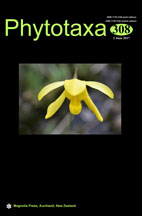Abstract
Since last account of the genus Aspidistra Ker Gawler (1822: 628) in Vietnam reported 43 species (Tillich 2014), at least 25 additional species were discovered and described in this country (Averyanov & Tillich 2014, 2015, 2016, Vislobokov et al. 2014a, 2014b, 2016, Leong-Skornickova et al. 2014, Olivier 2015, Ly & Tilllich 2015, Vislobokov 2015, 2016, Averyanov et al. 2016). Meanwhile, the diversity of the genus in Vietnam and allied countries remains insufficiently inventoried. One more new species of Aspidistra, named here as A. letreae was discovered recently in central Vietnam. This species is described and illustrated with data on its ecology, phenology, tentative relations, distribution and expected conservation status. The new species somewhat resembles Aspidistra truongii Averyanov & Tillich (2013: 108), A. obtusata Vislobokov (2016: 694) and Aspidistra zhangii Averyanov, Tillich & Nguyen in Averyanov et al. (2016: 62), but differs clearly by a series of morphological features noted below.

